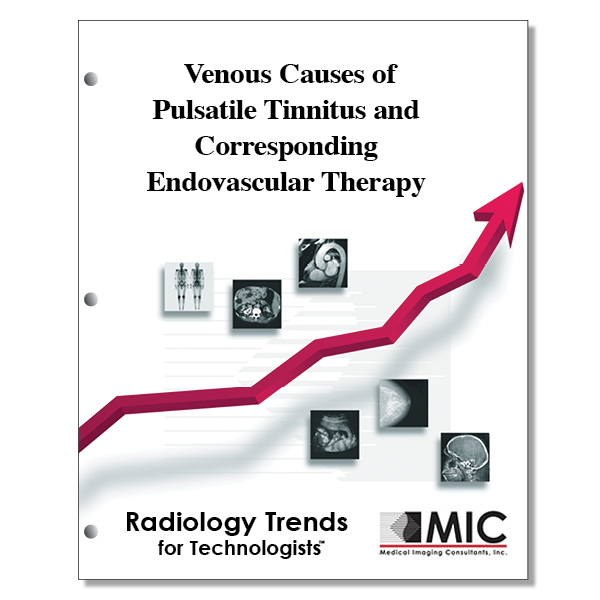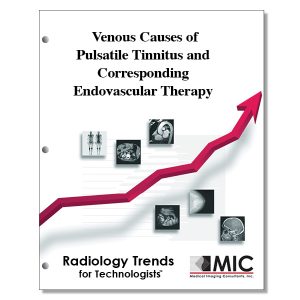

Venous Causes of Pulsatile Tinnitus and Corresponding Endovascular Therapy
A review of causes and treatments for pulsatile tinnitus, the auditory perception of rhythmic noise synchronous with the heartbeat.
Course ID: Q00667 Category: Radiology Trends for Technologists Modalities: CT, MRI, Vascular Interventional2.5 |
Satisfaction Guarantee |
$29.00
- Targeted CE
- Outline
- Objectives
Targeted CE per ARRT’s Discipline, Category, and Subcategory classification:
[Note: Discipline-specific Targeted CE credits may be less than the total Category A credits approved for this course.]
Magnetic Resonance Imaging: 1.00
Procedures: 1.00
Neurological: 1.00
Registered Radiologist Assistant: 1.75
Procedures: 1.75
Neurological, Vascular, and Lymphatic Sections: 1.75
Vascular-Interventional Radiography: 1.75
Procedures: 1.75
Vascular Diagnostic Procedures: 1.75
Outline
- Introduction
- Classification and Etiologic Causes of Tinnitus
- Imaging Approach to Patients with PT
- CT and MRI Technical Considerations
- Imaging Interpretation and Considerations for Endovascular Therapy
- An Anatomic-Based Approach to Identify the Causes of Venous PT
- Pathologic Abnormalities of the Lateral Sinuses
- Transverse Sinus Stenosis
- Sigmoid Sinus Wall Abnormalities
- Emissary Vein Anomalies and Variants
- Mastoid Emissary Vein
- Petrosquamosal Emissary Vein
- Condylar Veins
- Jugular Bulb Abnormalities
- HRJB Abnormality
- Jugular Bulb Dehiscence
- Jugular Bulb Diverticulum
- Other Causes of Venous PT
- Pathologic Abnormalities of the Lateral Sinuses
- Conclusion
Objectives
Upon completion of this course, students will:
- recall the origin of the word “tinnitus”
- choose the correct percentage of patients affected by subjective tinnitus
- provide the characterizations of pulsative tinnitus
- list the vascular causes of PT
- state the most common cause of PT in older adults
- list the venous causes of PT
- describe how patients should be evaluated for PT at noninvasive imaging
- choose the imaging study of choice to exclude cerebellopontine angle cistern or internal auditory canal lesions in patients with associated vertigo, dizziness, or hearing loss
- choose the imaging modalities that can be used as first-line methods to identify dural arterio-venous fistulas
- follow a diagnostic imaging algorithm to determine the proper imaging sequence
- describe how computed tomography protocols may differ between institutions
- state the sensitivity of the manual compression test for the prediction of venous lesions
- review Table 2 within the article to determine definitions for specific venous anomalies
- list the categories of venous pathologic abnormalities and variants that cause PT
- list pathologic abnormalities of the lateral sinus that cause PT
- state where enlarged arachnoid granulations may occur
- review images to determine stent placement for enlarged arachnoid granulations
- discuss interventions for arachnoid granulation
- define extrinsic stenosis
- define the 5 point scale used for grading the patency of the lateral sinus
- confirm how idiopathic intracranial hypertension is diagnosed
- state the most common symptom of idiopathic intracranial hypertension
- give the percentage of idiopathic intracranial hypertension patients that experience pulsatile and unilateral tinnitus
- state the most useful imaging finding of idiopathic intracranial hypertension
- give the percent of patients that experience headache relief after stent placement for transverse sinus stenosis
- give the failure rate of stents placed for transverse sinus stenosis
- choose the imaging procedure recommended to assess for follow-up of stent placement for transverse sinus stenosis
- list sigmoid sinus wall anomalies
- state the types of interventions for treatment of sigmoid sinus diverticulum
- choose the first line of treatment for narrow neck diverticulum
- list the layers of which the venous system of the head develop from
- list the anatomic categories of the main emissary veins
- state what vein serves as the main collateral pathway for venous drainage
- describe the location of the roof of a high-riding jugular bulb
- recall the name of the boney layer covering the jugular bulb
